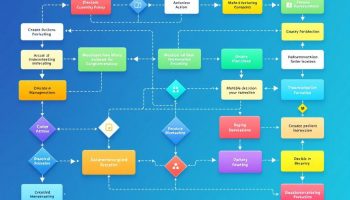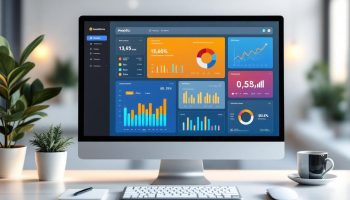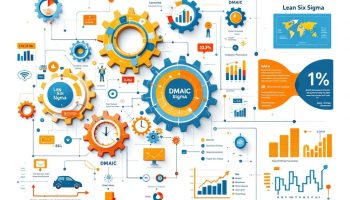
Supply Chain Optimization Through Data Science
Supply chain optimization through data science transforms logistics and inventory management by harnessing powerful analytical techniques. Integrating machine learning for supply chains, predictive analytics, and real-time data processing allows companies to achieve remarkable accuracy in demand forecasting, inventory control, and operational efficiency.
Key Takeaways:
- Data science enables up to 90% accurate demand forecasting across multiple data sources.
- Machine learning algorithms dynamically optimize inventory levels and reduce waste.
- Advanced analytics provide real-time visibility and proactive risk management capabilities.
- Supply chain optimization techniques can reduce operational costs by 5-10%.
- Integration of AI and IoT technologies creates more resilient and adaptive supply chain systems.
Data-driven approaches help you spot inefficiencies before they impact your bottom line. Modern analytics platforms process vast amounts of information from market trends, consumer behavior, and historical performance to generate actionable insights. This leads to better decision-making and improved supply chain resilience.
The impact extends beyond cost savings. Optimized routes reduce fuel consumption and carbon emissions. Accurate inventory forecasting minimizes waste from expired products. These benefits make data science not just financially attractive but environmentally responsible too.
Companies can start small with targeted implementations focused on specific pain points before expanding to comprehensive solutions. Each step builds capability while delivering immediate value through digital supply chain technologies.
“Supply chain optimization through data science revolutionizes logistics by harnessing the power of advanced analytics, allowing for up to 90% accuracy in demand forecasting and significantly reduced operational costs. By integrating machine learning and real-time data, organizations not only enhance efficiency but also build resilient systems capable of navigating the complexities of modern supply chains.”
Demand Forecasting: Predicting Market Dynamics
Harnessing the power of data science for supply chain optimization starts with accurate demand forecasting. Modern machine learning algorithms now analyze multiple data sources simultaneously, including historical sales patterns, market trends, weather fluctuations, and social media sentiment. This comprehensive approach enables you to predict customer demand with unprecedented accuracy—up to 90% in many cases.
By implementing predictive analytics and time series forecasting into your supply chain optimization data science strategy, you’ll optimize inventory levels while significantly reducing waste. These techniques allow for more dynamic supply chain planning that adapts to changing market conditions in real-time.
Coca-Cola demonstrates the transformative impact of advanced analytics in demand forecasting. Their implementation of sophisticated supply chain optimization data science tools achieved **90% forecasting accuracy**, allowing them to maintain optimal inventory levels across their vast distribution network.
Key Forecasting Techniques for Supply Chain Excellence
Several powerful techniques can enhance your forecasting capabilities:
- Time series analysis examines historical patterns to identify seasonality and trends
- Machine learning models that adapt to changing market conditions
- Ensemble methods combining multiple forecasting approaches
- Neural networks for complex pattern recognition in supply chain optimization data science
Integrating these forecasting methods with your existing supply chain analytics creates a more resilient and responsive system. You’ll gain the ability to anticipate market shifts rather than simply reacting to them.
The following table summarizes the benefits of data-driven demand forecasting:
| Benefit | Impact | Supply Chain Optimization Data Science Application |
|---|---|---|
| Inventory Optimization | 15-25% reduction in excess stock | ML algorithms determine optimal stock levels |
| Waste Reduction | Up to 30% decrease in perishable goods waste | Time-series forecasting predicts short-term demand |
| Customer Satisfaction | 10-20% improvement in order fulfillment | Predictive analytics ensures product availability |
| Cost Efficiency | 5-10% decrease in overall supply chain costs | Holistic data modeling optimizes resources |
Your supply chain transformation journey requires both technical expertise and strategic vision. By incorporating advanced forecasting capabilities powered by supply chain optimization data science, you’ll create a more agile operation capable of thriving in today’s volatile market conditions.
Expert Insight: **Professional Tip:** To excel in demand forecasting and supply chain optimization, leverage machine learning algorithms that analyze diverse data sources, including sales history, market trends, weather, and social media sentiment. This holistic approach can achieve up to 90% accuracy, enabling real-time adaptations that minimize waste and optimize inventory levels. By integrating advanced forecasting techniques such as time series analysis and neural networks, you can significantly enhance your predictive capabilities, ensuring your operation remains agile in today’s dynamic market.
Intelligent Inventory Management
You can drastically reduce holding costs while preventing stockouts by implementing data science for supply chain optimization in your inventory management. Modern AI and machine learning algorithms analyze multiple data points to dynamically optimize stock levels across your distribution network.
Real-time tracking has revolutionized inventory visibility. IoT sensors monitor product locations and conditions, while probabilistic models predict optimal inventory levels based on fluctuating demand patterns. This constant data flow helps improve supply chain processes by providing actionable insights.
Amazon exemplifies this approach with their AI-driven inventory replenishment system. Their algorithms analyze regional sales patterns, seasonal trends, and even local events to position inventory strategically across warehouses. You’ll notice similar benefits when implementing these techniques:
- Reduced capital tied up in excess inventory
- Minimized stockout situations even during demand spikes
- Lower warehouse costs through optimized storage allocation
- Decreased product obsolescence and wastage
- Improved cash flow from more efficient inventory turnover
Advanced Forecasting Integration
Your inventory management becomes truly intelligent when integrated with sophisticated demand forecasting. Machine learning algorithms can analyze historical sales data, market trends, weather patterns, and even social media sentiment to predict customer demand with remarkable accuracy.
The table below shows how supply chain optimization data science transforms traditional inventory approaches:
| Traditional Approach | Data Science Approach |
|---|---|
| Fixed reorder points | Dynamic reorder thresholds |
| Manual stock counts | Automated IoT tracking |
| Seasonal forecasting | Real-time demand sensing |
| Intuition-based ordering | Algorithm-driven replenishment |
| Reactive stockout handling | Proactive inventory positioning |
Major companies have achieved significant results through these methods. Coca-Cola reached 90% forecasting accuracy using advanced analytics, while data analytics optimized their entire supply chain. By applying similar techniques, you’ll gain a competitive edge through more efficient inventory management.
Supply chain optimization data science has become essential for companies seeking to balance customer satisfaction with operational efficiency. You’ll find that implementing these intelligent inventory systems reduces costs while improving service levels – a powerful combination for boosting profitability and market position.
Companies using intelligent inventory management can reduce their inventory costs by up to 30% while maintaining service levels.
forbes.com
Strategic Supplier Performance and Risk Management
You’ll gain a significant competitive edge by implementing data-driven supplier evaluation systems in your supply chain optimization data science strategy. These comprehensive analytics tools pull from multiple data sources to create a 360-degree view of supplier performance and potential risks.
Your procurement teams can monitor critical metrics like delivery timelines, quality consistency, pricing fluctuations, and even supplier financial health through automated data integration. This supply chain optimization data science approach transforms traditional vendor management into a strategic advantage.
Early risk identification becomes possible when you continuously analyze both internal procurement records and external market intelligence. The system can flag potential disruptions before they impact your operations by recognizing patterns invisible to manual monitoring.
The benefits of applying supply chain optimization data science to supplier management include:
- Reduced supply disruptions through predictive risk modeling
- Lower procurement costs via data-driven negotiation insights
- Improved product quality through statistical supplier evaluation
- Enhanced supply chain resilience with diversification recommendations
- Streamlined vendor qualification using automated scoring systems
Implementing Data-Driven Supplier Management
You’ll need to follow a structured implementation approach to maximize results. Start by creating a strategic planning framework that identifies your most critical supplier relationships and risk factors.
Next, establish your data collection infrastructure. This requires integration of your internal systems with external data sources, potentially including:
| Data Source | Key Metrics | Risk Indicators |
|---|---|---|
| Procurement Records | Delivery performance, quality ratings | Pattern deviations |
| Financial Databases | Credit scores, market stability | Downgrade alerts |
| News/Social Monitoring | Reputation issues, disruption events | Negative sentiment |
| Compliance Systems | Certification status, regulatory issues | Expiration warnings |
| Market Intelligence | Pricing trends, capacity utilization | Supply constraints |
With this foundation in place, you can develop supply chain optimization data science models that continuously evaluate supplier performance and provide actionable risk response strategies. These models allow for proactive intervention rather than reactive crisis management.
Many organizations find that implementing a supplier risk dashboard provides the visibility needed for effective decision-making. Your team can then focus on addressing high-priority issues while the system handles routine monitoring.

Route Optimization: Maximizing Logistics Efficiency
AI algorithms have revolutionized logistics by analyzing diverse data sets including traffic patterns, shipping data, delivery windows, and weather conditions to create optimal delivery routes with supply chain optimization data science at their core. You’ll see remarkable efficiency gains when implementing these systems, as evidenced by UPS’s ORION system which saves an impressive 100 million miles annually through intelligent route planning.
Your transportation costs will decrease significantly when implementing data-driven route optimization. By finding the most efficient paths, you’ll reduce fuel consumption and minimize carbon emissions while improving delivery times. Walmart’s implementation of supply chain optimization strategies helped them avoid 94 million pounds of CO₂ emissions, demonstrating the environmental benefits alongside operational improvements.
Key Components of Data-Driven Route Optimization
When implementing route optimization in your supply chain, you need to consider these essential elements:
- Real-time traffic analysis that adapts routes based on current conditions
- Weather pattern integration to avoid delays from environmental factors
- Delivery window prioritization to meet customer commitments
- Vehicle capacity optimization to maximize each trip’s efficiency
- Driver availability and specialization matching for appropriate assignments
- Fuel consumption modeling to reduce costs and environmental impact
Dynamic routing represents a significant advancement over static planning methods. You’ll experience improved delivery speed while simultaneously enhancing sustainability metrics through reduced mileage and emissions. The data science approach to supply chains enables continuous optimization as conditions change.
The implementation of route optimization technology requires integration with your existing supply chain management systems. You’ll need to connect warehouse management, order processing, and transportation management systems to create a cohesive optimization environment. This integration allows for continuous data flow that powers real-time decision-making and ensures your supply chain optimization data science initiatives deliver maximum value.
When evaluating route optimization solutions, consider both immediate operational benefits and long-term strategic advantages. Your organization will benefit from reduced costs, improved customer satisfaction through on-time deliveries, and enhanced sustainability credentials that increasingly influence consumer purchasing decisions.
Companies like UPS have demonstrated that advanced route optimization can save up to 10 million gallons of fuel annually, leading to significant cost savings and a reduction in carbon footprint.
hbr.org
Real-Time Supply Chain Visibility
You’ll gain tremendous advantages by implementing real-time visibility tools powered by supply chain optimization data science. IoT devices and advanced sensors now provide end-to-end tracking capabilities that transform how you monitor products throughout the entire supply chain journey. This technological evolution allows you to respond rapidly to disruptions and make intelligent inventory adjustments before small issues become major problems.
Benefits of Real-Time Tracking Systems
Companies implementing comprehensive tracking systems experience remarkable results. DHL has achieved 90-95% delivery forecast accuracy through their advanced supply chain optimization data science initiatives. A global consumer goods manufacturer reduced cold chain spoilage by 18% after deploying temperature sensors with real-time alerts. These improvements directly impact your bottom line while enhancing customer retention strategies.
Real-time visibility offers these critical advantages:
- Immediate disruption identification and response capabilities
- Precise inventory control across multiple locations
- Enhanced compliance documentation and verification
- Improved decision-making based on actual conditions
- Better coordination between supply chain partners
The integration of supply chain optimization data science tools with existing warehouse management systems creates a powerful framework for operational agility. You’ll be able to implement continuous improvement processes based on actual performance data rather than estimates or outdated information.
This visibility extends beyond simple location tracking. Modern systems monitor environmental conditions, handling procedures, and even product quality metrics throughout transit. When implemented properly, these systems reduce delivery exceptions by up to 25% while improving customer satisfaction through reliable service.
The following table illustrates how different visibility technologies address specific supply chain challenges:
| Technology | Supply Chain Challenge | Data Science Application | Result |
|---|---|---|---|
| RFID Tags | Inventory Accuracy | Pattern recognition algorithms | 99.9% tracking accuracy |
| IoT Sensors | Cold Chain Monitoring | Predictive temperature modeling | 18% reduction in spoilage |
| GPS Tracking | Transportation Efficiency | Route optimization algorithms | 15% reduction in miles traveled |
| Blockchain | Documentation Verification | Smart contract automation | 90% reduction in paperwork processing time |
By leveraging supply chain optimization data science for enhanced visibility, you’ll create a more resilient operation capable of adapting to changing market conditions and customer expectations.
Future of Data-Driven Supply Chains
You’ll witness revolutionary changes in supply chain operations as data science reshapes every aspect of the industry. Companies embracing supply chain optimization data science technologies gain significant competitive advantages through enhanced visibility, prediction accuracy, and operational efficiency.
Data science transforms demand forecasting by analyzing complex patterns in historical sales, market trends, weather conditions, and even social media signals. Machine learning algorithms now predict customer demand with up to 90% accuracy, helping you optimize inventory levels and reduce waste. Coca-Cola exemplifies this approach, achieving remarkable forecasting precision through advanced analytics techniques that interpret massive datasets.
Intelligent inventory management represents another breakthrough area. Dynamic stock optimization using AI balances having sufficient inventory without excess capital tied up. Real-time tracking through IoT sensors provides continuous visibility while probabilistic models determine optimal reorder points. Amazon’s AI-driven replenishment systems demonstrate how these technologies prevent stockouts while minimizing warehousing costs.
Strategic supplier evaluation has evolved beyond basic metrics. Data analytics now creates comprehensive supplier scorecards by integrating information from procurement records and external market intelligence. This approach helps you monitor performance and identify risks before they disrupt operations.
Route optimization stands out as a high-impact application of supply chain optimization data science. AI algorithms analyze traffic patterns, delivery windows, and weather conditions to determine optimal logistics paths. UPS’s ORION system saves 100 million miles annually, while Walmart avoided 94 million pounds of CO₂ emissions through similar technology.
Real-time visibility represents the backbone of modern supply chains. IoT devices provide end-to-end tracking that enables rapid responses to disruptions. DHL achieves 90-95% delivery forecast accuracy using these technologies, while a global consumer goods company reduced cold chain spoilage by 18% through continuous monitoring systems.
The future of data-driven supply chains includes:
- Integration of AI, machine learning, and digital twins for predictive modeling
- Supply chain robotics growing at 14% annually
- Enhanced resilience against geopolitical disruptions
- Sustainability improvements through supply optimization techniques
- Customer experience enhancements through data-driven personalization
With 83% of businesses prioritizing digital supply chain strategies, you’ll need to embrace these technologies to remain competitive. Supply chain optimization data science isn’t just about efficiency—it enables entirely new business models and customer experiences while building resilience against disruption.






